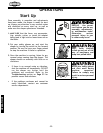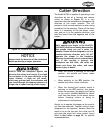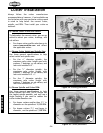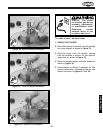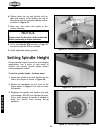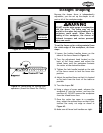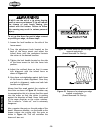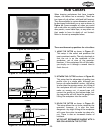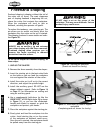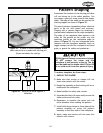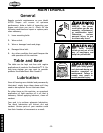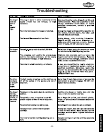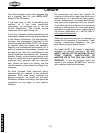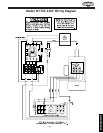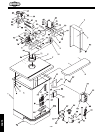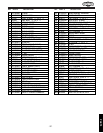
-30-
Freehand Shaping
Freehand shaping is shaping without the aid of
the miter slot or fence. The most dangerous
part of shaping freehand is beginning the cut,
where the cutter first contacts the workpiece.
Often the workpiece will tend to jerk or
kickback, catching the operator off guard.
To reduce this tendency, use a starting pin. The
pin allows you to anchor and slowly pivot the
workpiece into the cutter as the cut is started.
Thus shaping freehand is more stable and safer.
See Figure 50.
To set up the shaper for freehand shaping, do
these steps:
1. UNPLUG THE SHAPER!
2. Remove the fence assembly from the shaper.
3. Insert the starting pin in the best suited hole
on the table so you can feed the workpiece
into and against the rotation of the cutter.
4. Install the cutter so it will cut in the correct
direction, and adjust the spindle height.
5. Install the auxiliary guard. DO NOT use the
shaper without a guard. Refer to Figure 14
on Page 12 for information on making and
using an auxiliary guard.
6. Use a supplemental hold-down jig like the
SHOP FOX
®
W1500 Right Angle Jig as shown
in Figure 51, or you can use rubberized-
handle push blocks to support or guide the
workpiece and protect your hands.
7. Place the workpiece against the starting pin.
8. Slowly pivot and feed the workpiece into the
cutter. Avoid starting the cut on the corner
of the workpiece as kickback could occur.
Once the cut is started, the workpiece should
be pulled away from the starting pin.
ALWAYS use an auxiliary jig and extreme
care when shaping with the fence removed.
Freehand shaping often requires you to
remove the fence resulting in reduced
protection from the cutters.
DO NOT start a cut on the corner of the
workpiece. This may cause kickback. Serious
personal injury could occur.
Figure 50. Starting pin operation
(Guard not shown for clarity).
Figure 51. Hold-down jig used to support
workpiece
(Complete guard not shown for clarity).
OPERATIONS
Starting
Pin



